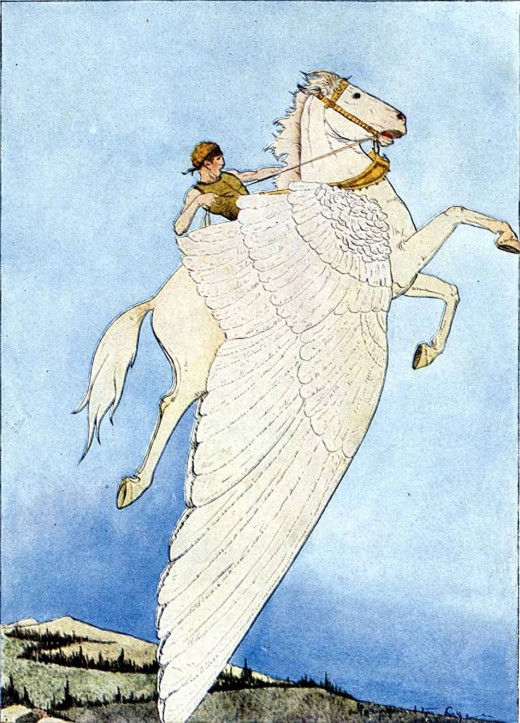Pegasus, The Story of a Winged Horse
His home was among the clouds, where he soared with snow-white wings unfurled. Pegasus, the winged horse, was the symbol of good triumphing over evil. Horse lovers understand how this creature found its way into mythology and fantasy. What equestrian, no matter how serious about their horsemanship, doesn't love the feeling of wings on hooves as they gallop at full speed across a field?

My grand daughter was a serious collector of model horses when she was a child. Her favorites were the mythological horses, unicorns and Pegasus. Pegasus, the winged horse, came to us through Greek mythology. This creature does not represent a species or tribe like the unicorn and centaur. In contrast, there was only one Pegasus, said in one legend to have been born from the blood that ran from Medusa's head after Perseus, son of Zeus, cut it off. Another version of the story says Pegasus' father is said to be Poseidon, god of the sea. Still another slant is that Medusa's blood mixed with sea foam to create Pegasus, which neatly ties in how Poseidon became its father.
Pegasus is a beautiful white horse with angelic wings. We find the Pegasus image in art all through the ages. He was known for his courage and beauty. Many wanted to tame him, but he eluded all their efforts. That was until a prince named Bellerophan came along.
Legend tells us that Bellerophan, who was a prince from Corinth, desperately wanted to tame Pegasus. He appealed to the goddess Athena for help. Athena gave Bellerophan a golden bridle, which had magical powers. With the bridle he was able to capture and subdue the winged horse.
With help from the winged horse Bellerophan had many adventures. He killed the fire breathing monster Chimera and won battles against the mythological Amazons, a fierce race of women who were the enemies of Greece.
Things were going really well with Pegasus as a partner. But Bellerophon became proud and wanted more power. He began to think of himself as a god. Pegasus knew better, and when Bellerophan tried to ride Pegasus to Mount Olympus where the gods lived, Pegasus dumped him.
After the winged horse threw his rider back to earth, Zeus made Pegasus into a constellation. Pegasus was given run of the Olympian stables and was allowed to fetch thunderbolts and lightning for Zeus.
In another legend it is said that the fountain Hippocrene sprang forth at the strike of Pegasus' hoof. Pegasus did this at the command of the God Poseidon, when the Muses were having a song contest and made Mount Helicon grow toward heaven. The mountain stopped growing, but the water from the fountain inspired people to write poetry. Mm, horse, muse, writer, equine journalist. It all fits nicely.
Although there was only one Pegasus, many heroes in medieval literature rode a steed called the hippogryph. Similar to the Pegasus, the hippogryph was a cross between the male griffon and a mare. Creatures that fit this description can be seen in the work of Leonardo da Vinci. The griffin was a blend of lion, eagle, and serpent. So, combine this with the horse and you've got one super-charged war machine, the front legs were talons of the eagle and the hindquarters that of the horse. What a formidable foe this creature must have been to its enemy with talons, teeth and hooves ripping and striking. Somehow I prefer the picture of the Winged Horse carrying the gods triumphly through the sky, where we can watch on clear, starry night.









